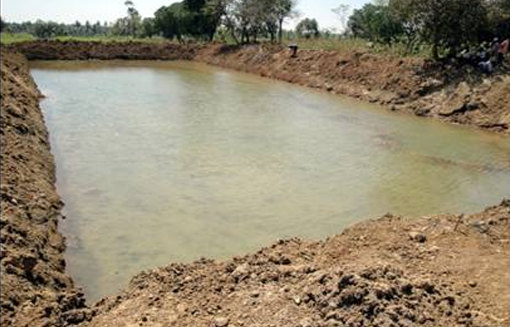Pond preparation & management
Pond Preparation and Management

Pond preparation and management plays a crucial role in Aquaculture. In intensive and semi intensive farming pond should be prepared properly before beginning of the crop season for optimum results. In Aquaculture, bottom soil play major role in pond yield. High organic matter content in neutral soil often promotes higher productivity and hence high profits. Natural food organisms are one of the most important food sources in ponds. It is rich in protein, vitamins, minerals and other essential growth elements that simple supplementary feed cannot complete. Fish yield in pond can also be affected by the presence of predators, deteriorating water quality and improper pond management. Hence, pond preparation is a first step towards ensuring a better pond production.
Aquaculture in Indian sub continent can be grouped into three major categories:
- Culture that depend entirely on natural food (extensive culture)
- Culture that depend on both natural food and supplementary feeds
- Culture that depend entirely on artificial diet (intensive culture)
Irrespective of the culture method & mode, it is always advisable to prepare the ponds in sustaining high natural productivity throughout the culture period.
Soil Sampling
Prior to pond preparation, soil samples are collected from the pond bottom for pH and organic matter contents analysis. Soil pH analysis is generally conducted to determine lime requirement. This procedure is important for newly developed ponds where the occurrence of acid sulphate soils is common. When acidic soil condition is detected, corrective measures can be incorporated in the pond preparation activities. Sampling of soil is not necessary for well conditioned ponds
Leaching
When the pond soil is found to be acidic, it is normally “leached. This is done by flushing and washing the pond bottom with water to leach away undesirable metallic compounds like aluminium, iron and excess sulphur ions
Pond drying
The drying of the pond bottom is an effective method for eliminating undesirable species in pond prior to the culture period. Drying oxidizes harmful chemical substances especially sulphides and facilitates mineralization of organic matter. The pond is dried until the soil cracks or when it is firm enough to hold one's weight without sinking more than 5 cm on walking over the surface.
Tilling
Tilling or ploughing of bottom soil improves soil quality by exposing subsoil to the atmosphere thereby speeding up the oxidation process and the release of nutrients that are locked in the soil
Control of Aquatic Plants& undesirable species
Aquatic weeds pose threat to Shrimp / Fish by consuming feed and also reduce the amount of oxygen available in the pond causing depletion of DO levels. Water hyacinth, topapana, ipomoea aquatica, helenca, maloncho are harmful for the growth of aquatic animals. Competitors are species that compete for space, food, oxygen, etc. with the cultured stock. Generally, these are of different species. It is essential to minimize competition by adequate management procedures in stocking of shrimp fry and prevention of undesirable species from entering the pond.
Liming
Liming is the application of calcium and magnesium compounds to the soil for the purpose of reducing soil acidity. It is usually applied during or after the pond drying stage. Liming kills most of the microorganisms, raise pH of acidic water to neutral or slightly alkaline value, promotes biological productivity by enhancing the breakdown of organic substances by bacteria creating more favorable oxygen and carbon reserves, precipitates suspended or soluble organic materials, decreases biological oxygen demand (BOD), increases light penetration, enhances nitrification and indirectly improves fine-textured bottom soil in the presence of organic matter
Excessive liming, however, can be damaging because it decreases phosphorus availability through precipitation of insoluble calcium or magnesium phosphate
Fertilization
Pond fertilization is an important and necessary step in extensive and semi-intensive methods of farming operations. The usual way for increasing carrying capacity of pond is to improve its natural fertility through the addition of organic or inorganic fertilizers. Both organic and non-organic (chemical fertilizer) fertilizers are necessary for production of phytoplankton and zooplankton in the pond. Applying fertilizer in the pond increases the growth and production of fish and also increases the availability of food of fish.
Pond Management:
Quality of water has direct impact on the quality and quantity of the harvest. Water quality determines not only how well shrimp/fish will grow, it directly affects survival rate and profitability. Aquatic animals influence water quality through processes like nitrogen metabolism and respiration. Dissolved oxygen (DO) levels, temperature and ammonia have direct impact on morbidity and mortality of the cultured stock. Other factors such as pH, alkalinity, hardness and clarity also affect overall growth of the fish/shrimp but usually are not directly toxic.
Various methods are available to monitor the quality of pond water. In low intensity or semi intensive culture doesn’t need high precision analytical methods. However intensive Shrimp/Fish farming demands for sophisticated monitoring techniques at frequent intervals. If aquatic animals are maintained at high densities, then temperature, dissolved oxygen (DO), ammonia, nitrite, and pH should be monitored on daily basis. Water clarity, alkalinity, and hardness can be measured once or twice a week as they won’t fluctuate rapidly. Salinity levels, iron and chlorine levels should be determined when water source is examined so that corrective measures can be incorporated into the production system during planning stage. Hydrogen sulphate and Carbon dioxide (CO2) need close monitoring and corrective measures should be kept handy.
Regardless of the frequency, monitoring should be done at a standard time and depth. Time of measurement and observed values should be recorded; good record keeping is essential for successful aquaculture. In pond and cage culture it is preferable to monitor dissolved oxygen early in the morning, when stressful conditions are most likely to occur (e.g., low oxygen). Conversely, temperature and pH in ponds are best measured during the late afternoon.
